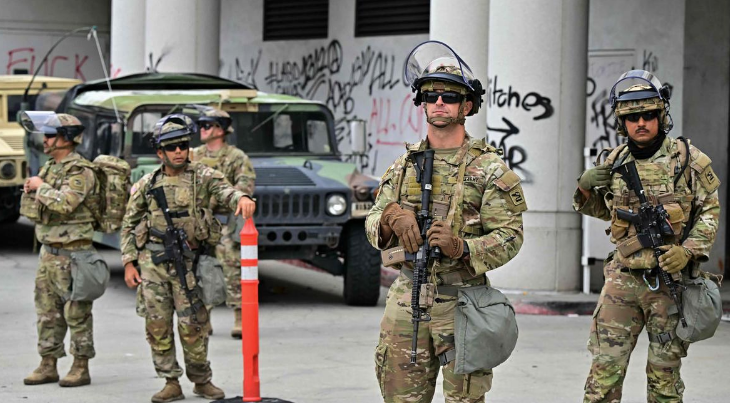
Crisis and Command: The 1965 National Guard Deployment Explained
The National Guard was sent into action by then-President Lyndon B. Johnson in March 1965, the night before the civil rights march from Selma to Montgomery, Alabama.
A unusual action that the California governor has called a “serious breach of state sovereignty” is the deployment of 2,000 National Guard troops by US President Donald Trump to put an end to immigration rallies in Los Angeles. Gavin Newsom has called for its urgent reversal.
This followed protests over the weekend in Los Angeles over federal immigration sweeps that resulted in the arrest of hundreds of people. Police fired tear gas and rubber bullets to disperse the gathering as demonstrators blocked motorways and set self-driving cars on fire. Later, the demonstrations expanded throughout the city and even made their way to Compton and Paramount. The use of presidential powers, which had lain dormant for several decades, is a significant development that calls into question both the authority of the state and long-standing norms.
The fact that the National Guard was sent without the state governor’s request adds to the dire circumstances that now exist. More than 60 years have passed since this type of incident occurred.
When A US President Bypassed Governor To Deploy National Guard
The National Guard was sent into action by then-President Lyndon B. Johnson in March 1965, the night before the civil rights march from Selma to Montgomery, Alabama.
In order to protest Alabama’s systematic denial of voting rights to Black Americans, the Selma to Montgomery marches were arranged. Only 2% of Black citizens were registered to vote, while making up more than half of the city’s population. This resulted from intimidation by local authorities, literacy exams, and discriminatory laws.
The death of Jimmie Lee Jackson, a young Black man shot by a state policeman during a nonviolent protest, served as the movement’s immediate catalyst. In order to demand federal protection of voting rights and to bring national attention to the violent repression of Black voters, civil rights activists, including Martin Luther King Jr., planned to march from Selma to Montgomery, the state capital.
The deployment was made in an effort to manage the escalating hostilities between demonstrators and police officers. It’s interesting to note that Johnson chose to defend protesters from violence without the assistance of George Wallace, the state governor at the time and a well-known segregationist in the US whom the president viewed as a political rival.
The last time a US president deployed the National Guard without consulting the state governor was in 1965, when he exercised his limited executive authority.
Because he is in charge of the troops, the state governor usually has to seek the activation of the National Guard.
Trump claimed on his Truth Social platform that the city mayor and the governor of California ought to apologise to the people of Los Angeles for the “absolutely horrible job that they have done, and this now includes the ongoing LA riots. These are insurrectionists and troublemakers, not protestors. Don’t forget, no masks!” he continued.
White House spokesperson Karoline Leavitt said California officials “completely abdicated their responsibility” to safeguard the residents, while Newsom referred to the president’s action as an unwarranted provocation.
The Council on Foreign Relations stated that US presidents “rarely federalise a state or territory’s guard without the consent of the governor” in an online fact sheet that provides an overview of the National Guard’s history.
According to a source in The New York Times, Johnson explained his decision in 1965 by stating that it was made to protect American citizens’ rights “to walk peaceably and safely without injury or loss of life from Selma to Montgomery, Alabama.” After Mr. Wallace declined to give the directives in this respect, he made his decision.


